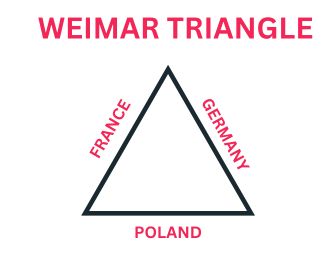The Weimar Triangle represents the changing dynamics of European diplomacy and collaboration in the post-Cold War era. Established in 1991, this trilateral project including France, Germany, and Poland has played an important role in maintaining stability, mutual understanding, and advancing the European integration process. The Weimar Triangle, which has its roots in Europe’s historical difficulties, represents a commitment to dialogue, cooperation, and reconciliation among states with different historical backgrounds and geopolitical interests.
Table of Contents
Historical Context:
To comprehend the Weimar Triangle’s significance, one must first examine the historical circumstances in which it originated. The aftermath of World War II decimated Europe economically and politically. During the Cold War, the continent was divided into two ideological blocs, with Germany representing the divide between East and West. However, the collapse of communism in Central and Eastern Europe, as well as Germany’s reunification, marked a new age of transition and potential for European cooperation.

Origins of the Weimar Triangle:
It is a regional partnership between France, Germany, and Poland that was formed in 1991 in Weimar, Germany. The group aims to foster cooperation among the three countries on cross-border and European issues. This diplomatic initiative arose in the aftermath of the Cold War, as European countries attempted to rethink their connections and create greater cooperation. Poland’s membership in the Weimar Triangle was especially noteworthy since it provided an opportunity for the country to improve ties with its Western neighbors and more completely integrate into the European Union.
Objectives:
The Weimar Triangle has several key objectives:
Promotion of Regional Stability: One of the primary objectives is to help Central and Eastern Europe maintain stability and security. By encouraging communication and cooperation among France, Germany, and Poland, the initiative hopes to address mutual concerns and promote regional peace.
Enhancement of European Integration: It acts as a forum for encouraging deeper European integration. France, Germany, and Poland cooperate within the framework of the European Union (EU) to achieve common goals and deepen the European integration process.
Promotion of Mutual Understanding: It seeks to foster mutual understanding and trust between France, Germany, and Poland. Through frequent consultations and exchanges, the program aims to strengthen ties and promote a feeling of common identity and purpose among the three countries.
Facilitation of Trilateral Collaboration: It serves as a venue for trilateral collaboration on a variety of topics, including political, economic, cultural, and security challenges. Working together, France, Germany, and Poland may more effectively solve common difficulties and pursue shared partnership opportunities.
Support for Poland’s Integration into Europe: For Poland, the Weimar Triangle is a vital instrument for deepening ties with Western Europe and fully integrating into the European community. Participating in the program allows Poland to enhance its interaction with France and Germany while also contributing to the molding of Europe’s future.
Overall, the Weimar Triangle reflects France, Germany, and Poland’s commitment to supporting peace, stability, and prosperity across Europe. The three countries hope to establish a stronger and more integrated Europe capable of addressing the complex issues of the 21st century through ongoing cooperation and dialogue.
Future Prospects:
Looking ahead, the Weimar Triangle remains an important part of European diplomacy and cooperation. As Europe faces new difficulties such as geopolitical conflicts, economic uncertainty, and worldwide pandemics, tight cooperation and solidarity among its states remain critical.
It can serve as an example of efficient multilateralism and regional cooperation in Europe and elsewhere. By building on its successes and resolving its challenges, the initiative can help to shape a more stable, prosperous, and interconnected Europe in the years ahead.
Conclusion:
The Weimar Triangle represents a symbol of European unity, cooperation, and reconciliation. Through dialogue, cooperation, and mutual understanding, France, Germany, and Poland have worked together to promote stability, strengthen European integration, and define Europe’s future. As Europe navigates the problems of the 21st century, the Weimar Triangle remains an important venue for diplomatic engagement and regional collaboration, reflecting its member states’ longstanding dedication to the values of peace, democracy, and solidarity.
FAQs
What is the Weimar Triangle?
The “Weimar Triangle” is a regional partnership between France, Germany, and Poland that was formed in 1991 in Weimar, Germany. The group aims to foster cooperation among the three countries on cross-border and European issues.
Who are the members of the Weimar Triangle?
Countries that form the Weimar Triangle are France, Germany and Poland.
Very well point wise written, thanks for making it convenient for revision
Hey people!!!!!
Good mood and good luck to everyone!!!!!